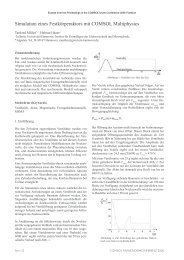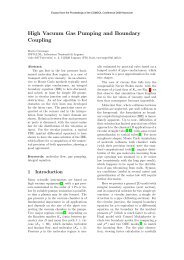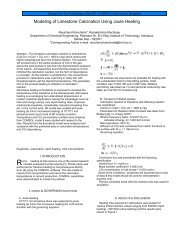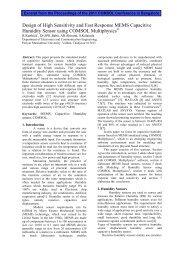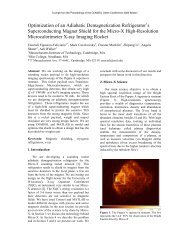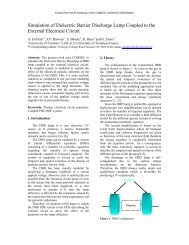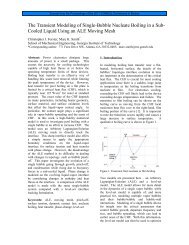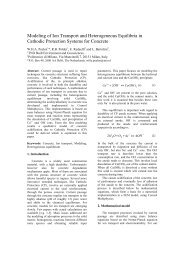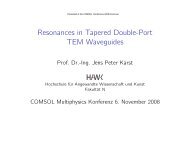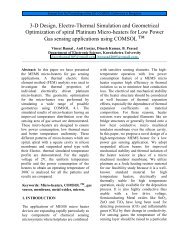Improved finite element modeling of heat and mass ... - COMSOL.com
Improved finite element modeling of heat and mass ... - COMSOL.com
Improved finite element modeling of heat and mass ... - COMSOL.com
Create successful ePaper yourself
Turn your PDF publications into a flip-book with our unique Google optimized e-Paper software.
<strong>Improved</strong> <strong>finite</strong> <strong>element</strong> <strong>modeling</strong> <strong>of</strong> <strong>heat</strong> <strong>and</strong> <strong>mass</strong> transfers in<br />
single corn kernels during drying<br />
A. Kovács*, E. <strong>and</strong> M. Neményi<br />
University <strong>of</strong> West Hungary, Institute <strong>of</strong> Biosystems Engineering, Mosonmagyaróvár, Hungary<br />
*Corresponding author: 2 Vár, Mosonmagyaróvár, 9200, Hungary; email address: kovacsaj@mtk.nyme.hu<br />
Abstract: Modeling <strong>of</strong> agricultural (biological)<br />
materials is very <strong>of</strong>ten used for describing<br />
physical processes. Our Institute at the West<br />
Hungarian University is dealing with <strong>modeling</strong><br />
<strong>of</strong> <strong>heat</strong> physical treatments in agricultural<br />
(biological) materials. The essential key in order<br />
to gain accurate results is to know the driving<br />
forces during <strong>heat</strong> <strong>and</strong> <strong>mass</strong> transfers. In case <strong>of</strong><br />
<strong>mass</strong> transfer processes the application <strong>of</strong><br />
moisture gradient as driving force gives false<br />
results. Therefore, we use water potential<br />
gradients as the driving force. However, this<br />
needs exact physical measurements: the water<br />
potential curves <strong>of</strong> the materials have to be<br />
determined. The lower section <strong>of</strong> the water<br />
potential curves can be calculated from the<br />
sorption isotherms. Determination <strong>of</strong> water<br />
potential above saturation <strong>of</strong> corn kernel<br />
particles (starch, germ <strong>and</strong> pericarp) is difficult<br />
due to its perishable nature as a biological living<br />
material. This measurements were carried out at<br />
the Institute <strong>of</strong> Hydrology Slovak Academy <strong>of</strong><br />
Sciences in Bratislava by using a so called<br />
"pressure plate extractor" method adapted from<br />
soil science for measurements <strong>of</strong> pF values6 (soil<br />
water potential). For <strong>modeling</strong> the <strong>COMSOL</strong><br />
Multiphysics 4.1 s<strong>of</strong>tware is used for the<br />
calculation the coupled <strong>heat</strong> <strong>and</strong> <strong>mass</strong> transfer in<br />
corn kernels. This is an improved model <strong>of</strong> an<br />
earlier COSMOS <strong>and</strong> later FEMLAB application<br />
(Kovacs et al., 2008). Modifications were carried<br />
out on geometry: extra plant anatomical structure<br />
namely the hilar layer was added. The input<br />
constants were also refined (specific <strong>heat</strong>s,<br />
diffusion coefficients, etc.). The results give<br />
more realistic temperature <strong>and</strong> moisture<br />
migration within the grain. The main result is<br />
that the moisture content <strong>of</strong> different particles<br />
inside the kernel never equalize (in contrast to<br />
the misleading case where the driving force is<br />
the moisture gradient). The results were verified<br />
in real drying conditions by thermography (by<br />
using a FLIR PM675 type thermo-camera) <strong>and</strong><br />
magnetic resonance imaging (at the BRUKER<br />
Microimaging Application Group, Karlsruhe,<br />
Germany).<br />
The authors express their thanks for the financial<br />
support <strong>of</strong> the Hungarian Scientific Research<br />
Found (No.: K69014).<br />
Keywords: <strong>heat</strong> <strong>and</strong> <strong>mass</strong> transfer, <strong>finite</strong><br />
<strong>element</strong> <strong>modeling</strong>, drying.<br />
1. Introduction<br />
The characteristics <strong>of</strong> the <strong>heat</strong> <strong>and</strong> <strong>mass</strong><br />
transfers in the bodies are determined first <strong>of</strong> all<br />
by the structure <strong>of</strong> the material. The living or<br />
once lived (e.g. agricultural <strong>com</strong>modities)<br />
materials are anisotropic, inhomogeneous <strong>and</strong><br />
<strong>com</strong>plex. In biological materials structural <strong>and</strong><br />
dimension changes happen during environmental<br />
change or artificial external effect. These<br />
changes result hysteretic type functions (e.g.<br />
sorption isotherms). Moreover, most <strong>of</strong> the time<br />
chemical processes are initiated (e.g.<br />
denaturation) during unfavorable condition<br />
changes; <strong>and</strong> giving energy to the system causes<br />
endothermic or exothermic reactions. All <strong>of</strong> the<br />
above mentioned facts can be basically also true<br />
for non-living materials, however in biological<br />
materials phenomena appear together. In order to<br />
get better acquainted with these processes we<br />
have to enhance the mathematical models<br />
describing the <strong>heat</strong> <strong>and</strong> <strong>mass</strong> transfer processes<br />
first <strong>of</strong> all physical correctness point-<strong>of</strong>-views. In<br />
the past authors basically dealt with the<br />
<strong>modeling</strong> <strong>of</strong> <strong>heat</strong> <strong>and</strong> <strong>mass</strong> transfer in cereal<br />
grains, <strong>and</strong> therefore have literature experiences<br />
first <strong>of</strong> all in this area. The simplifications were<br />
the followings: (i) the materials were considered<br />
to be homogenous <strong>and</strong> isotropic, therefore<br />
density (moisture concentration) gradient was<br />
used as the driving force <strong>of</strong> the <strong>mass</strong> transfer; (ii)<br />
some parameters (first <strong>of</strong> all the transfer<br />
coefficients) were considered to be constants;<br />
(iii) <strong>com</strong>plex geometries were simplified to<br />
squares or spares. As the result <strong>of</strong> these<br />
simplifications the models could follow only in<br />
certain accuracy the integral moisture content<br />
changes or the average temperature changes.
Exact physical measurements are needed as<br />
input parameters for the models. Knowing the<br />
driving potentials (forces) during <strong>heat</strong> <strong>and</strong> <strong>mass</strong><br />
transfers are necessary for an accurate model.<br />
Water potential gradients as the driving force are<br />
used in contrast with the practice (where<br />
moisture gradients were used) for <strong>modeling</strong> <strong>of</strong><br />
<strong>mass</strong> transfer in maize hybrids. For this the water<br />
potential curves <strong>of</strong> the materials are have to be<br />
determined. Desorption isotherms were<br />
measured on 40 <strong>and</strong> 50 °C <strong>of</strong> maize hybrids <strong>and</strong><br />
their constituents (pericarp, scutellum,<br />
endosperm.).<br />
Water potential curves can be either directly<br />
calculated from the sorption equations. On the<br />
other h<strong>and</strong> sorption isotherm measurements <strong>of</strong><br />
agricultural materials have been carried out for<br />
decades [3]. Several papers were published for<br />
w<strong>heat</strong> <strong>and</strong> maize grains’ isotherms [4, 5, 6, 7].<br />
Most <strong>of</strong> the cases different salt solutions were<br />
used to set the relative humidity <strong>of</strong> the measuring<br />
chamber <strong>and</strong> the kernels were set until<br />
equilibrium weight. The method is time<br />
consuming <strong>and</strong> the kernels can deteriorate<br />
especially over 80% RH [4]. The literature data<br />
<strong>of</strong> the sorption isotherms <strong>of</strong> maize constituents<br />
are in controversy [1, 2]. First <strong>of</strong> all data <strong>of</strong> the<br />
high moisture content region is differ. Other<br />
difficulties are the great number <strong>of</strong> empirical<br />
equation that present in literature [8, 9]. A<br />
general equation has not been developed so far.<br />
Special measurement technique is required to<br />
determine the higher sections <strong>of</strong> the water<br />
sorption isotherms. Direct measurements for<br />
water potential were initiated using a „pressure<br />
plate extractor” (PPS) developed at the<br />
University <strong>of</strong> Saskatchewan, Canada for<br />
measuring soil samples [10]. The PPS consist <strong>of</strong><br />
a calibrated ceramic plate <strong>and</strong> a pressurized<br />
chamber. This method was adapted from soil<br />
science where measurements <strong>of</strong> pF values (soil<br />
water potential) are well known. In this way a<br />
water content <strong>of</strong> the sample is determined in<br />
such way that the <strong>mass</strong> <strong>of</strong> the sample <strong>and</strong> the<br />
equipment are measured together.<br />
2. Governing Equations<br />
The basic governing differential equation<br />
system for the drying processes was given by<br />
Luikov [11]. It was simplified by Husain et al.<br />
[12] in the following form:<br />
�X<br />
� �(<br />
D�X<br />
)<br />
��<br />
(1)<br />
�T �X<br />
� � �k�T<br />
� L�<br />
(2)<br />
��<br />
��<br />
where: X is the moisture content d.b. [kg/kg]; D<br />
is the diffusion coefficient [m 2 /s]; � is the<br />
density [kg/m 3 ]; c is specific <strong>heat</strong> [J/kgK]; T is<br />
the temperature [K]; � is the time [s]; k is the<br />
thermal conductivity [W/mK]; L is the latent<br />
<strong>heat</strong> <strong>of</strong> vaporization <strong>of</strong> water [J/kg].<br />
The previously mentioned simplifications<br />
were realized by other scientist <strong>and</strong> they try to<br />
consider the problem by e.g. taking account the<br />
different physical properties <strong>of</strong> the different<br />
constituents [13, 14]. Other way was to give the<br />
coefficients as functions instead <strong>of</strong> constants<br />
[15].<br />
The above equation systems proved that<br />
inside moisture distribution in e.g. a single maize<br />
kernel <strong>and</strong> the calculated distribution does not<br />
agree [16]. The authors try to enhance the model<br />
accuracy by taking account the non-permeability<br />
<strong>of</strong> the epithelium layer between the scutellum<br />
<strong>and</strong> germ [17]. The biggest problem with the s<strong>of</strong>ar<br />
used <strong>modeling</strong> is that the model intents to<br />
equalize the moisture concentration that is not<br />
correct since the moisture content <strong>of</strong> the<br />
constituents are different in equilibrium state<br />
(Fig. 1.).<br />
Moisture content <strong>of</strong> the constituents,<br />
X [kg/kg]<br />
0.6<br />
0.5<br />
0.4<br />
0.3<br />
0.2<br />
0.1<br />
endosperm<br />
scutellum<br />
0.0<br />
0.05 0.10 0.15 0.20 0.25 0.30 0.35<br />
Moisture content <strong>of</strong> the whole kernel, X [kg/kg]<br />
Figure 1. Moisture content <strong>of</strong> the particles vs.<br />
whole maize kernels.<br />
Based on the above mentioned facts it is<br />
clear that the using moisture gradient as the<br />
driving force is not correct. Luikov [11] took the<br />
water potential (<strong>mass</strong> transfer potential) the same<br />
way as the <strong>heat</strong> transfer potential (temperature).<br />
He proposed cellulose as the st<strong>and</strong>ard body. The<br />
authors give the following equation for <strong>mass</strong><br />
transfer potential based on the chemical potential<br />
<strong>of</strong> ideal gases <strong>and</strong> considering that the material is<br />
a capillary-porous body:
R �T<br />
� (3)<br />
U � � � ln�<br />
X<br />
mV<br />
where: φ is the relative humidity <strong>of</strong> the air<br />
(decimal); RU is the universal gas constant; mv is<br />
the molecular weight <strong>of</strong> vapor.<br />
The sorption isotherm equations ψ(X,T) can<br />
be determined [6] based on the function (Fig. 2.):<br />
[kJ/kg]<br />
Water potential, ���<br />
X m<br />
equilibriu � f ( T,<br />
�)<br />
(4)<br />
In this case the Eq. 1. can be redrawn [8]:<br />
�X<br />
��<br />
� � �X<br />
��<br />
� � � �X<br />
��<br />
� � � �X<br />
��<br />
�<br />
�<br />
�<br />
D �<br />
�<br />
� �D<br />
� � �<br />
�<br />
D �<br />
��<br />
��<br />
�x<br />
� ��<br />
�x<br />
� �y<br />
� � ��<br />
� �<br />
� ��<br />
�y<br />
� z z �<br />
200<br />
[kJ/kg]<br />
150<br />
100<br />
50<br />
0<br />
(5)<br />
0 0.1 0.2 0.3 0.4 0.5 0.6<br />
Moisture content, X [kg/kg]<br />
Figure 2. Water potential curves <strong>of</strong> maize<br />
particles as a function <strong>of</strong> moisture content (d.b).<br />
The above mentioned equation system was<br />
solved with the <strong>COMSOL</strong> Multiphysics s<strong>of</strong>tware<br />
[17]. Fig 3. shows the mesh window <strong>of</strong> a maize<br />
kernel that was based on an actual image <strong>of</strong> a<br />
grain.<br />
Figure 3. Finite <strong>element</strong> mesh <strong>of</strong> a maize kernel<br />
3. Results <strong>and</strong> Discussion<br />
Endosperm<br />
Scutellum<br />
The results are more accurate because they<br />
follow the physical theories. The theory <strong>and</strong><br />
practical applications <strong>of</strong> the models can be<br />
extended to other processes occurring in living<br />
materials (e.g. water movements), not only in<br />
drying application <strong>of</strong> agricultural <strong>com</strong>modities.<br />
The results <strong>of</strong> this model followed well the<br />
measurements <strong>of</strong> sorption isotherms <strong>and</strong> nuclear<br />
magnetic resonance imaging (MRI), unlike the<br />
models based on the moisture gradients as the<br />
driving force (Figs. 4 <strong>and</strong> 5).<br />
Fig. 4. shows that the water potential moves<br />
one equilibrium state (�Before drying) to an other<br />
equilibrium state (�n), where the potentials are<br />
not the same but they are homogeny. The<br />
inhomogeneous moisture distribution before<br />
drying remains inhomogeneous after drying that<br />
is seen on Fig. 5.<br />
The evaluation the model - e.g. by magnetic<br />
resonance imaging (Fig. 6.) - proved that the<br />
<strong>mass</strong> transfer equation with water potential<br />
gradient was correct [18]. The magnetic<br />
resonance imaging (MRI) is a non-destructive<br />
<strong>and</strong> non-invasive technique that enables the<br />
moisture distribution inside intact kernels to be<br />
determined.<br />
4. Conclusion<br />
The description <strong>of</strong> the <strong>heat</strong> <strong>and</strong> <strong>mass</strong> transfer<br />
processes is very difficult, because the moisture<br />
movement depends on the number <strong>of</strong> features. In<br />
the majority <strong>of</strong> cases the researchers have to<br />
simplify the calculation methods, consequently a<br />
limited number <strong>of</strong> parameters have to be taken<br />
into consideration. By calculating the <strong>mass</strong><br />
transfer the most characteristic method was the<br />
use <strong>of</strong> moisture concentration gradient as a<br />
driving force. However, from physical point-<strong>of</strong>view<br />
in <strong>com</strong>posites <strong>and</strong> inhomogeneous<br />
materials the correct way for <strong>modeling</strong> <strong>of</strong> <strong>heat</strong><br />
<strong>and</strong> <strong>mass</strong> transfer is the use <strong>of</strong> <strong>mass</strong> transfer<br />
potential (G) gradient. This method is difficult to<br />
ac<strong>com</strong>plish at the biological materials. The most<br />
suitable method to determine the moisture<br />
transfer potential is the use <strong>of</strong> the pF function <strong>of</strong><br />
the different <strong>com</strong>ponents [pF (water activity,<br />
temperature)]. The partial derivative <strong>of</strong> the<br />
moisture content with respect to the <strong>mass</strong><br />
transfer potential is the specific isothermal <strong>mass</strong><br />
capacity, which is according to our experiences<br />
constant in the most cases at the biological<br />
<strong>com</strong>ponents. Considering these facts the solving
<strong>of</strong> the partial differential equation systems will<br />
be simplified.<br />
Finite <strong>element</strong> method is applied to solve the<br />
<strong>heat</strong> <strong>and</strong> <strong>mass</strong> transfer equations. The <strong>COMSOL</strong><br />
Multiphysics s<strong>of</strong>tware is used for the calculation<br />
<strong>of</strong> the <strong>com</strong>posite biological materials (corn<br />
constituents, starch, vegetables - carrots).<br />
Before drying 60 min 120 min 180 min 240 min <strong>of</strong> drying<br />
Figure 4. Moisture potential changes in a cross section <strong>of</strong> a maize hybrid kernel during (�) drying<br />
calculated by <strong>COMSOL</strong> Multiphysics program (drying temperature: 40 °C).<br />
Before drying 60 min 120 min 180 min 240 min <strong>of</strong> drying
Figure 5. Moisture content distribution during drying <strong>of</strong> a maize kernel calculated from the result <strong>of</strong> model<br />
where water potential was the drying force.<br />
Before drying 30 min 60 min 90 min<br />
Figure 6. Measurements <strong>of</strong> magnetic resonance<br />
imaging (MRI) <strong>of</strong> actual drying maize kernels<br />
for evaluating the <strong>finite</strong> <strong>element</strong> <strong>modeling</strong> <strong>of</strong><br />
<strong>mass</strong> transfer<br />
5. References<br />
1. Shelef, L.; Mohsenin, N.N. Moisture relations<br />
in germ-endosperm <strong>and</strong> whole corn kernel.<br />
Cereal Chemistry, 43, pp. 347-353 (1966)<br />
2. Chung, D.; Pfost, H. Adsorption <strong>and</strong><br />
desorption <strong>of</strong> water vapour by cereal grains <strong>and</strong><br />
their products. Transactions <strong>of</strong> the ASAE, 4, pp.<br />
549-551, 555 (1967)<br />
3. Babbit, J. D. Hysteresis in the adsorption <strong>of</strong><br />
water vapour by w<strong>heat</strong>. Nature. Sept. 1. Pp. 265-<br />
266 (1945)<br />
4. Henderson, S. M. A basic concept <strong>of</strong><br />
equilibrium moisture. Agricultural Engineering,<br />
pp. 29-32 (1952)<br />
5. Thompson, H. J., Shedd, C. K. Equilibrium<br />
moisture <strong>and</strong> <strong>heat</strong> <strong>of</strong> vaporization <strong>of</strong> shelled corn<br />
<strong>and</strong> w<strong>heat</strong>. Agricultural Engineering, Vol. 35.<br />
No. 11. pp. 786-788 (1954)<br />
6. Day, D. L., Nelson, G. L. Desorption<br />
isotherms for w<strong>heat</strong>. Transactions <strong>of</strong> the ASAE,<br />
Vol. 8, No. 2., pp. 293-297(1965)<br />
7. Strohman, R. D., Yoerger, R. R. A new<br />
equilibrium moisture-content equation.<br />
Transactions <strong>of</strong> the ASAE, pp. 675-677 (1967)<br />
8. Iglesias, H. A., Chirife, J. H<strong>and</strong>book <strong>of</strong> fo<strong>of</strong><br />
isotherms: water sorption parameters for food<br />
<strong>and</strong> food <strong>com</strong>ponents. Academic Press, New<br />
York. (1982)<br />
9. ASAE St<strong>and</strong>ards American Society <strong>of</strong><br />
Agricultural Engineering, 45th Edition, St.<br />
Joseph, MI. (1998)<br />
10. Imre, E.; Rajkai, K.; Czap, Z.; Figri, T.;<br />
Telekes, G.; Aradi, L. Comparative<br />
measurements with s<strong>and</strong> box, pressure<br />
membrane extractor <strong>and</strong> pressure plate extractor.<br />
Unsaturated Soils for Asia, Rahardjo, H.; Toll,<br />
D.G.; Leong, E.C. (Eds), Balkema, Rotterdam<br />
(2000)<br />
11. Luikov, A. V. Heat <strong>and</strong> Mass Transfer in<br />
Capillary - porous Bodies, Pergamon Press<br />
(1966)<br />
12. Husain, A.; Chen, C. S.; Clayton, J. T.<br />
Simultaneous <strong>heat</strong> <strong>and</strong> <strong>mass</strong> diffusion in<br />
biological materials. J. Agric. Eng. Res., 18, 343-<br />
354 (1973)<br />
13. Gustafson, R. J.; Thompson, D. R.;<br />
Sokhansanj, S. Temperature <strong>and</strong> stress analysis<br />
<strong>of</strong> corn kernel – <strong>finite</strong> <strong>element</strong> analysis. Trans.<br />
ASAE, 22, 955-960 (1979)<br />
14. Sokhansanj, S.; Gustafson, R.J. In:<br />
Mujumdar, A. S. (Ed.): Prediction <strong>of</strong> Heat <strong>and</strong><br />
Mass Transfer within a Grain Kernel – A Finite<br />
Element Application, Drying ’80 Proceedings <strong>of</strong><br />
the Second International Symposium, 2.<br />
McGraw-Hill, New York, 229-232 (1980)<br />
15. Neményi, M.; I. Czaba; A. Kovács; T. Jáni<br />
Investigation <strong>of</strong> simultaneous <strong>heat</strong> <strong>and</strong> <strong>mass</strong><br />
transfer within the maize kernels during drying,<br />
Computers <strong>and</strong> Electronics in Agriculture, 26,<br />
123-135 (2000)<br />
16. Kovács, A. J.; M. Neményi Moisture<br />
gradient vector calculation as a new method for<br />
evaluating NMR images <strong>of</strong> maize (Zea mays, L.)<br />
kernels. Magn. Reson. Imaging, 17(7), 1077-<br />
1082 (1999)<br />
17. Neményi, M.; A. J. Kovács Finite <strong>element</strong><br />
<strong>modeling</strong> <strong>of</strong> simultaneous <strong>heat</strong> <strong>and</strong> <strong>mass</strong> transfer<br />
using Femlab, EurAgEng 2002. International<br />
Conference on Agricultural Engineering, 30<br />
June – 4 July Budapest. CD-ROM. Edited by the<br />
Scientific Society <strong>of</strong> Mechanical Engineering<br />
(GTE) (2002)<br />
18. Neményi, M. Modeling <strong>of</strong> Coupled Heat <strong>and</strong><br />
Moisture Transfer in Grain Kernels by Modified<br />
Luikov’s Equations. 3rd IFAC/CIGR Workshop<br />
on Control Applications in Post-Harvest <strong>and</strong><br />
Processing Technology (CAPPT 2001), 3-5 Oct.,<br />
Tokyo, Japan (2001)<br />
6. Acknowledgements<br />
The authors wish to thank for the support <strong>of</strong><br />
the Hungarian Scientific Research Found (No.:<br />
K69014).



